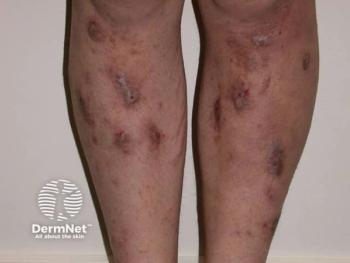
‘Chaos’ algorithm simplifies biopsy decision
The “Chaos & Clues” decision algorithm allows physicians to decide for or against biopsy at the speed of a normal examination, without making complex calculations, one of its developers says.
Las Vegas - A new decision-making algorithm for pigmented skin lesions combines accuracy with speed and simplicity, according to one of its developers who spoke at the Cosmetic Surgery Forum, held here.
The Chaos & Clues Dermatoscopic Decision Algorithm for Pigmented Skin Malignancy replaces the cumbersome qualities of many previous diagnostic tools with straightforward analysis that physicians can perform at the speed of a normal examination, says Cliff Rosendahl, M.B.B.S., Ph.D., a primary care physician based in Brisbane, Australia, who specializes in skin cancer.
Classic pattern analysis remains the most accurate method of melanoma diagnosis, he allowed. “Nothing has been shown to be better. But you must memorize lists of clues for every different condition, look at the lesion, match the features with memorized lists and come up with a diagnosis,” he says. “And the other methods almost all require calculations.” When using the ABCD rubric, for example, one must assign a numerical value to each variable, and then total these values. “Imagine doing that for 50 lesions on a patient.”
Conversely, he says, “The presence of chaos can usually be assessed at the speed of a blink.”
As such, the “Chaos & Clues” algorithm is a method designed for all pigmented skin lesions, to detect malignancy of any type -
“You don’t have that first step. You want to diagnose all malignancies, not just the melanocytic ones,” Dr. Rosendahl says.
Defying natural laws
Natural physical laws favor symmetry, he says. The “Big Bang,” for example - an explosion in a vacuum - sent cosmic matter with equal force in all directions. Likewise, “If a tree evolves asymmetrically, it falls over.”
However, “Malignant cells defy natural laws. When the P53 gene mutates and DNA replication is not stalled to allow repair after damage, the result is unrestrained tumor proliferation and asymmetry. That’s why chaos or asymmetry is fundamental to malignant tissue,” Dr. Rosendahl says.
More specifically, he defines chaos as asymmetry of structure or color. All previous diagnostic methods acknowledged the importance of asymmetry as a clue to malignancy, he adds. “We just called color and structure, combined asymmetrically, ‘chaos.’”
Ruling out a suspicious lesion does not require it to have a perfectly symmetrical shape, he cautions - just an overall symmetrical pattern. In contrast, to help spot malignancies, he recommends looking for the “ugly duckling,” a lesion that breaks the pattern of surrounding nevi, for example.
If chaos is absent, he says, “Move to the next lesion. If chaos is present, stop and examine for one of eight clues to malignancy.” These include the following:
- Gray or blue structures;
- Eccentric structureless area (any color except skin color);
- Thick lines, reticular or branched (thicker than the holes they surround);
- Black dots or clouds, peripherally located in a lesion;
- Lines - radial or pseudopods, segmental;
- White lines;
- Polymorphous vessels;
- Lines parallel, ridges (palms or soles) or chaotic (nails).
There are, however, four exceptions in which symmetrical lesions should be assessed for biopsy. This is necessary to detect very early malignancies and symmetrical nodular melanomas and to move the sensitivity of the method closer to 100 percent.
- Changing lesions on adults;
- Nodular or small lesions with any clue;
- Lesions on the head or neck with any dermatoscopic grey;
- Parallel ridge pattern (palms or soles).
“Prediction without pigment is also a simple method,” Dr. Rosendahl says. For nonpigmented lesions, he explains, one should biopsy if the lesion has ulceration or white clues (white lines in any lesion, or in a raised lesion white circles, surface keratin or a white structureless area). For lesions without ulceration or white clues, the algorithm recommends analyzing the pattern of vessels. In a flat lesion, for example, Dr. Rosendahl says a polymorphous pattern including vessels in a pattern of dots is very specific for melanoma. Conversely, in a raised lesion without ulceration or white clues, a serpiginous or “string of pearls” vessel arrangement is specific for clear cell acanthoma.
Diagnostic sensitivity
In a study co-authored by Dr. Rosendahl, “We evaluated 463 consecutive pigmented skin lesions from my practice over a period of several years. We showed firstly that dermatoscopy improved the diagnostic accuracy for non-melanocytic lesions as well as melanocytic ones (Rosendahl C, Tschandl P, Cameron A, Kittler H. J Am Acad Dermatol. 2011;64(6):1068-1073).”
More importantly, the Chaos & Clues algorithm demonstrated a sensitivity of 90.6 percent for diagnosing any type of malignancy and a specificity of 62.7 percent. Additionally, the latter figure improved to 77.4 percent when investigators could rule out seborrheic keratosis, solar lentigines and lichen-planus-like keratosis via pattern analysis.
Therefore, Dr. Rosendahl says, the new algorithm’s tested accuracy is equivalent to that of several existing methods such as the ABCD rubric, but it’s much simpler to apply.
“Of course whatever the method, such percentages are influenced by the selection bias in the test series used. In real life specificity is much higher (we removed a minute percentage of benign lesions encountered) and sensitivity cannot be measured because we do not know how many malignancies are missed,” he says.
Newsletter
Like what you’re reading? Subscribe to Dermatology Times for weekly updates on therapies, innovations, and real-world practice tips.


















